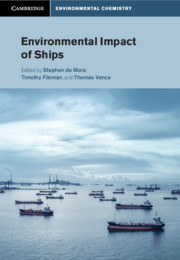Book contents
- Environmental Impact of Ships
- Cambridge Environmental Chemistry Series
- Environmental Impact of Ships
- Copyright page
- Contents
- Contributors
- Preface
- 1 Shipping, Ships and the Environment
- 2 Atmospheric Emissions from Ships
- 3 Oil Pollution from Operations and Shipwrecks
- 4 Waste and Sewage
- 5 Ballast Water
- 6 Biocides from Marine Coatings
- 7 Invasive Species
- 8 Physical Effects of Ships on the Environment
- 9 Ship Noise
- 10 Vessel Strikes and North Atlantic Right Whales
- 11 Nuclear-Powered Vessels
- 12 Environmental Impacts of Shipbreaking
- 13 International Legislative Framework
- 14 Shipping Industry’s Perspective
- 15 Environmental Impacts of Shipping
- Index
- References
11 - Nuclear-Powered Vessels
Published online by Cambridge University Press: 22 January 2021
- Environmental Impact of Ships
- Cambridge Environmental Chemistry Series
- Environmental Impact of Ships
- Copyright page
- Contents
- Contributors
- Preface
- 1 Shipping, Ships and the Environment
- 2 Atmospheric Emissions from Ships
- 3 Oil Pollution from Operations and Shipwrecks
- 4 Waste and Sewage
- 5 Ballast Water
- 6 Biocides from Marine Coatings
- 7 Invasive Species
- 8 Physical Effects of Ships on the Environment
- 9 Ship Noise
- 10 Vessel Strikes and North Atlantic Right Whales
- 11 Nuclear-Powered Vessels
- 12 Environmental Impacts of Shipbreaking
- 13 International Legislative Framework
- 14 Shipping Industry’s Perspective
- 15 Environmental Impacts of Shipping
- Index
- References
Summary
This chapter outlines the development of nuclear-powered marine propulsion, considering submarines and other naval vessels, together with icebreakers and unsuccessful commercial ships. During shipboard operations, nuclear wastes such as metallic and gaseous radioisotopes are captured by ion exchange and eventually returned to land for disposal. The principal environmental concerns with respect to all reactor operations, apart from something going wrong, are the issues surrounding the decommissioning and ultimate disposal of the spent nuclear fuel, the reactor, and other components that have become contaminated or made radioactive as a result of neutron activation. Incidents relating to nuclear powered submarines are catalogues, noting that the fate of some of the vessels remain unknown. Finally, the Human and environmental consequences of reactors lost and dumped at sea are discussed.
- Type
- Chapter
- Information
- Environmental Impact of Ships , pp. 282 - 302Publisher: Cambridge University PressPrint publication year: 2020
References
- 1
- Cited by



